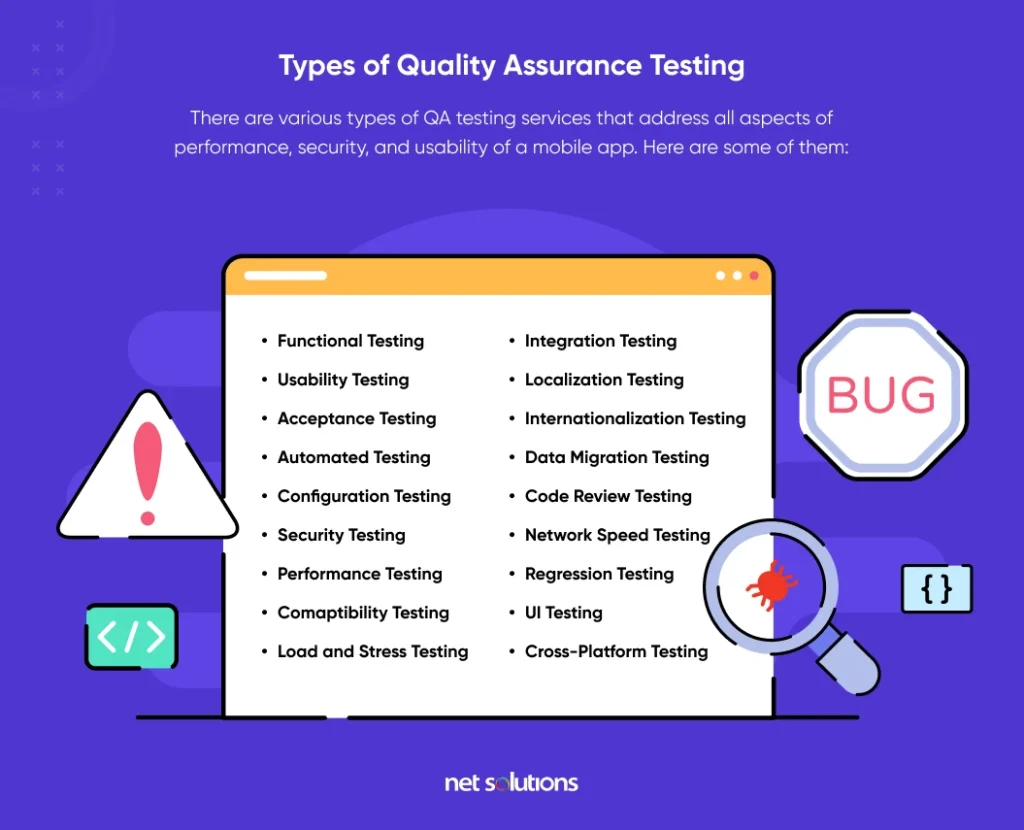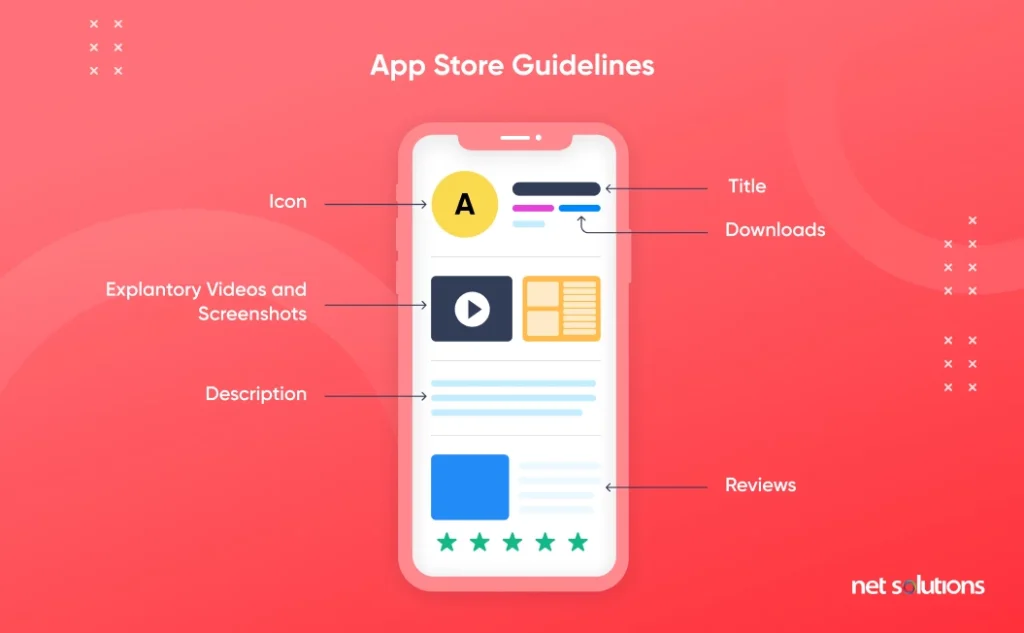Are you thinking about creating your mobile app? You might want to consider a few things to make your app successful. Check this 7-step mobile development checklist to know about key considerations and why these are so essential in the process.
Mobile apps have become an integral part of our lives, and by 2027 the total revenue from the mobile app market is expected to exceed $360 billion USD.
If you’re thinking of entering the mobile app market with a promising new app idea (or even if you’re just planning to launch an app for internal use within your organization), it’s important to recognize that developing a mobile app requires some special considerations compared to other types of software development. That’s why Net Solutions has put together a mobile app development checklist, along with this accompanying blog post to explain the “why” behind each step.
If you’re thinking about creating your own mobile app, whether you’re part of an in-house software development team or you’re considering outsourcing the task to a partner, read through this post. Then download our mobile app development checklist to share with your entire team or outsource partner.
What is a Mobile App Development Checklist?
A mobile app development checklist is a step-by-step guide that covers everything necessary to create a mobile app. A good mobile app checklist includes all the important elements of mobile app development that differ from the steps required to create desktop software.
Why use a Mobile App Development Checklist?
The market for mobile apps is lucrative, but it’s also highly competitive. If your Minimum Viable Product (MVP) isn’t viable enough—for instance, say it has major security gaps or it fails to meet the app store’s requirements—you’ll face an uphill battle. Following Net Solutions’ mobile app checklist along with these mobile app development tips will increase your odds of success.
The “Why” Behind Each Step in the Mobile App Checklist
Net Solutions’ mobile app checklist covers all the major steps in mobile app development, from understanding your users to improving your product post-deployment.
Download our mobile app development checklist to share with your design and development teams (whether in-house or outsourced), and read this post to understand the rationale behind each step.
7 Steps in Our Mobile App Development Checklist
Step 1: Understand the Market and Plan Your Business Strategy
The first step in the mobile app checklist is to understand the market, including the latest mobile app development trends, needs and drives of prospective users and the competitive landscape. One great thing about creating an app is that there’s plenty of Voice of the Customer (VoC) data readily available from your competitors’ customers on the app stores. Diving into those reviews will give you a clear idea of what the market wants and which options are currently lacking in your competitors’ products.
Understand the Market (via competitors’ products and user reviews)
- Research your competitors to see what similar apps offer
- Explore competitors’ app reviews to understand what the market craves
- List out competitor features and note which ones clients want + what’s lacking
- Take note of how competitors monetize their apps to guide your own strategy
- Interview and survey your target audience to understand what they want
- Analyze the research and decide which market segment you want to focus on
- Work to find a niche in the market you can address
- Identify the problem you’re trying to solve for that specific market segment
- Create user personas based on your data
Create Your Product Vision
- Create a product roadmap that identifies your most important features
- List your “must-have” features that will make-or-break the product
- List your “nice-to-have” features that you can leave out of this version if resources run low
- Decide how much data you want to collect from your users (balancing privacy with the need to understand user behavior and improve your app)
Establish the Technical Requirements
- Will your app work with iOS? Android? Both? Each has its own technical requirements
- Identify the cloud-based infrastructure required to run your app
- Select programming languages you intend to target, i.e., Java/kotlin for Android app development, Swift/Objective-C for iOS app development.
Defining the Business Strategy
- Estimate the cost to build the mobile app
- Set a budget for the project
- Create risks analysis and risk mitigation strategies for the project
- Identify your monetization model after exploring your competitors’ models
- Brainstorm mobile app features, workflows, and your app’s look and feel
- Select the best design ideas, filtering out the not-so-great ones
- Rank your requirements so your Design and Development teams know what to prioritize
- Create an outline of your Minimum Viable Product (MVP) if that’s the model you’re using
- Create a Proof of Concept to explore the product’s viability
- Build a timeline for the project
- Set a marketing/advertising budget for the app
Step 2: Design the App
During your app’s design phase, you’ll focus on software architecture prototyping and User Experience (UX) design. This involves collaboration between Business Analysts and Designers. During this phase, your teams will:
- Communicate requirements to the design team, spelling out the project’s requirements and the intelligence you’ve gathered on the current market
- Build wireframes to visualize the app’s workflows
- Gather feedback from potential users
- Set project benchmarks and milestones
- Establish the Mobile app architecture
- Set Quality Assurance (QA) requirements so the QA team will understand what to test
- Have the UX and UI teams build a prototype so the engineering team can visualize the build
Step 3: Develop the App
Mobile app developers have to consider a number of factors related to their development strategy, app performance, security, and more. Use the following list to ensure your app development team checks all the right boxes.
Create your software development strategy
- Will you use an in-house team? Will you outsource? Will you use both for different elements of the project?
- If outsourcing, fully vet your development company (learn more about selecting an outsourcing partner)
- Choose a development methodology (such as Waterfall or Agile)
- Build a project plan to keep the team on track
- Ensure clear communication between developers and other departments
Consider factors related to mobile app performance
- Choose a web service (if applicable) to streamline and integrate the app with other services
- Decide whether to take a server-side approach (which would hide the source code from the public)
- Decide between vertical scaling vs. horizontal scaling (the vertical approach scales by adding additional nodes, while horizontal scaling requires you to upgrade computing power as you scale)
- Decide whether you’ll receive crash notifications in real-time
Discuss how the app should perform in a range of conditions, such as:
- Areas with minimal network coverage
- Times when battery life is low
- Points where users are low on storage space
- Other atypical conditions
Consider security factors for your app
- Use data encryption to protect your mobile app from data breach.
- Decide whether to include two-factor authentication for extra security
- Strongly consider including Secure Socket Layers (SSL) to encrypt data transfer
- Decide on any restrictions for people who want to access the app
- Choose whether to include sub-admins that would grant certain users limited admin privileges
- Ensure you’re adhering to any relevant legal requirements (such as GDPR in Europe and HIPAA regulations in the U.S.) that may affect your business
- Establish a secure payment gateway if you’re accepting payments through your app
Step 4: App Quality Assurance (QA) Testing

Quality Assurance (QA) testing is a vital element of any software release strategy. Apps require a few extra steps, which you’ll read about below.
- Decide on manual vs. automated testing (or employ both)
- Set your API testing strategy to ensure seamless integration with other platforms or services (if applicable)
- Perform cross-device compatibility and performance testing
- Analyze the codebase for security risks to protect vital data
- Ensure your localization strategy works as planned to appeal to different areas
- Confirm that your app will work with upcoming OS updates
- Check multilingual versions of the app to ensure the text works visually for each localized version of the app
- Communicate all issues to the development team
- Allow engineers to fix any bugs and get the app running smoothly
- Have the QA team validate the app and clear it for deployment
Step 5: Deployment & Marketing
When it comes to public-facing apps, deployment and marketing are integrally connected since apps are released on the Apple and Google Play stores. In other words, since these platforms are the gatekeepers that allow users to access your app, how you present your brand and your product on the marketplace is a key aspect of deployment. The following steps will guide you in both your deployment and marketing efforts.
- Ensure your product meets the app store guidelines so it gets approved to become (and remain) available to the public
- Perform app store optimization on your mobile app to ensure it ranks higher in the store. Use clear descriptions and clear screenshot images to offer users a taste of what they’ll be downloading. Also, attach reviews and testimonials for social proof.
- Consider providing tutorial videos so the learning curve isn’t too steep for new users
- Gather preliminary feedback from users so you can improve your product

Step 6: Evaluate Your App’s Performance
Data will start rolling in following each release. Evaluate your app’s performance as it relates to the following data.
- Number of downloads
- Total visitors
- Active users
- Average session length
- Point in the customer workflow where users leave
- Conversion rate
- Estimated Customer Lifetime Value (CLV)
- App store ratings
- Support response time
- Advertising ROI
Step 7: Maintenance
- Analyze your performance data and makes notes for future releases
- Learn from customer feedback and reviews to improve your app
- Fix any bugs that pop up, reducing the issues in future releases
- Prioritize new features that you’ll integrate into upcoming releases
Choosing a Development Partner
If you’re considering outsourcing your app development to a software development partner, there are a number of factors to consider—from the team’s expertise to their communication skills and cultural alignment. That’s why we put together a 10-point guide to help you create a solid outsourcing strategy, should you decide to go that route.
Frequently Asked Questions
1. What software and language should I learn to develop a mobile app?
To develop an Android app, start with Kotlin/Java. Most apps are built in Java, but these days people are also using Kotlin extensively.For iOS, Swift is a great choice. But if you’re willing to dabble into hybrid app development, you should learn cross-platform app development frameworks like ReactNative and Flutter.
2. How can I build an app for free?
There are many low-code or no-code development platforms in the market. You can choose any of them. However, there’s a bit of learning curve you might have to overcome with them. Also, the customization options are limited in these platforms.
A no-code / low-code platform is good to test an initial theory but in the long run, not the best choice since you don’t own the Intellectual Property or the Source Code.
3. How can I make money with my app?
You can choose from various app monetization strategies like in-app purchases, subscription-based model, affiliate marketing, freemium approach, and advertisements to make money from your app.
SHARE THIS POST
Table of Contents
Related Resources
- What is App Store Optimization (ASO)? The in-depth guide for 2024
- The Mobile App Architecture Guide for 2024
- How Much Does it Cost to Build an App [A Complete Breakdown]
- How To Protect Data In Mobile & Web Apps Using Encryption
- eCommerce Mobile App Development: A Step-by-Step Guide
- 7-Step Mobile App Development Checklist (Free Download)
- How Firebase is Emerging as an Innovation in App Development
- A Complete Guide to Implementing In-App Purchases
- Low-Cost Mobile App Development: A Comprehensive Guide
- How to Make an App in 2024: 5 Stages of Mobile App Development
- What is Mobile-first Design (+9 Best Practices)
- The Ultimate Guide for New App Ideas
- Offshore Mobile App Development: An In-Depth Guide
- Most Popular Programming Languages for Mobile App Development
- The 7 Best Programming Languages to Write & Develop Native Android Apps
- 7 Mobile App Development Tips for Acquisition & Retention
- Top 15 Mobile App Development Trends to Watch for in 2024
- The Fundamentals of Android App Development: Basic Tutorial

